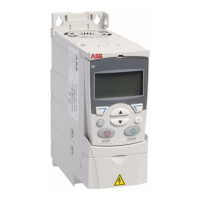Application macros 109
PID control macro
This macro provides parameter settings for closed-loop control systems such as
pressure control, flow control, etc. Control can also be switched to speed control
using a digital input. To enable the macro, set the value of parameter 9902 APPLIC
MACRO to 6 (PID CONTROL).
For the parameter default values, see section Default values with different macros on
page 165. If you use other than the default connections presented below, see section
I/O terminals on page 49.
Note: Parameter 2108 START INHIBIT must remain in the default setting 0 (OFF).
Default I/O connections
X1A
1 SCR Signal cable shield (screen)
2AI1 Output freq. ref. (Hand) / Process ref. (PID): 0…10 V
1)
3 GND Analog input circuit common
4 +10V Reference voltage: +10 V DC, max. 10 mA
5AI2 Process actual value: 4…20 mA
3)
6 GND Analog input circuit common
7AO Output frequency value: 0…20 mA
8 GND Analog output circuit common
9 +24V Auxiliary voltage output: +24 V DC, max. 200 mA
10 GND Auxiliary voltage output common
11 DCOM Digital input common
12 DI1 Stop (0) / Start (1) (Hand)
13 DI2 Hand (0) / PID (1) control selection)
14 DI3 Constant speed 1: parameter 1202
CONST SPEED 1
15 DI4 Run enable
16 DI5 Stop (0) / Start (1) (PID)
X1B
17 ROCOM Relay output 1
No fault [Fault (-1)]
18 RONC
19 RONO
20 DOSRC Digital output, max. 100 mA
No fault [Fault (-1)]
21 DOOUT
22 DOGND
max. 500 ohm
1…10 kohm
2)
1)
Hand: 0…10 V -> output freq. reference.
PID: 0…10 V -> 0…100% PID setpoint.
2)
360 degree grounding under a clamp.
3)
The signal source must be powered
externally. See the manufacturer’s
instructions. An example of a connection
using a two-wire sensor is given on page 51.
Tightening torque: 0.4 N·m (3.5 lbf·in).

